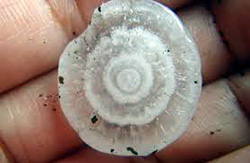
Hail stones actually have rings, showing the number of “trips” up and down the atmosphere.
As the sun rises on a typical July morning the ground will begin to warm up. The air above the ground is also being heated by the ground. This process is creating “lift” in the atmosphere. As “bubbles” of warm air being to rise across north Georgia, large cumulus clouds begin to develop. Hot air is much less dense than cold air so it tends to rise in altitude. When we send up weather balloons we get a nice thermal profile and can see how quickly the temperature decreases with height. The faster the temperature drop, the more unstable the atmosphere becomes. When the environment is ripe, the warm, humid air rises rapidly and to great heights. As the moisture in the air condenses, sometimes very quickly, hail will form.
If the updrafts of air are strong, a hail pellet being pulled to the ground by gravity will often be forced back up into the top of the cloud, refreezing as it collides with raindrops. This process can happen over and over again until the hail becomes heavy enough to overcome the storm updraft. If you are the curious type, you can cut a hail stone open and see rings. Each ring will tell you how many times the stone was forced back up into the cloud. When you see a large hail stone in your yard, you know you have a powerful updraft. If hail that is 3/4-inch in diameter occurs, that is considered severe hail and a severe thunderstorm warning will be issued by the National Weather Service.
Hail, as we all know, can cause quite a bit of damage to our homes, cars, and gardens. However, it is not responsible for what kills more people every year than tornadoes. That is lightning. A billion watts of electricity with 300,000 volts. It is about an inch in diameter and is 50,000 degrees hot, five times hotter than the surface of the sun. This is what worries me most about everyone out on the lake during a hot summer afternoon. You can estimate how far a storm is from you by counting the number of seconds from the time you saw the bolt until you hear the thunder. For every 5 seconds you count, that equals a distance of one mile.
Our summer storms don’t last too long. Their average lifespan is about 30-60 minutes. They are dangerous from beginning to end. At the end of the storm’s life, cold air will eventually overcome the warm updrafts of air that started the storm. This cold air is thick and dense and falls from the cloud at great speeds and slams into the ground, fanning out in all directions. If the speed of the wind exceeds 58 mph, the weather service will once again issue a severe thunderstorm warning.
From beginning to end, these guys can pack a punch. Be careful out there this summer. Our storms continue to get more powerful. Download an app, like the WSB Severe Weather Team 2 app. It’s free and you will always be alerted to approaching storms.
Photo: Courtesy of the National Weather Service




